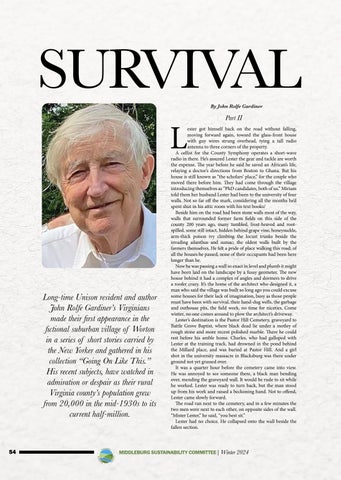SURVIVAL By John Rolfe Gardiner
L
Long-time Unison resident and author John Rolfe Gardiner’s Virginians made their first appearance in the fictional suburban village of Worton in a series of short stories carried by the New Yorker and gathered in his collection “Going On Like This.” His recent subjects, have watched in admiration or despair as their rural Virginia county’s population grew from 20,000 in the mid-1930s to its current half-million.
54
Part II
ester got himself back on the road without falling, moving forward again, toward the glass-front house with guy wires strung overhead, tying a tall radio antenna to three corners of the property. A cellist for the County Symphony operates a short-wave radio in there. He’s assured Lester the gear and tackle are worth the expense. The year before he said he saved an African’s life, relaying a doctor’s directions from Boston to Ghana. But his house is still known as “the scholars’ place,” for the couple who moved there before him. They had come through the village introducing themselves as “PhD candidates, both of us.” Miriam told them her husband Lester had been to the university of four walls. Not so far off the mark, considering all the months he’d spent shut in his attic room with his text books/ Beside him on the road had been stone walls most of the way, walls that surrounded former farm fields on this side of the county 200 years ago, many tumbled, frost-heaved and rootspilled, some still intact, hidden behind grape vine, honeysuckle, arm-thick poison ivy climbing the locust trunks beside the invading ailanthus and sumac; the oldest walls built by the farmers themselves. He felt a pride of place walking this road; of all the houses he passed, none of their occupants had been here longer than he. Now he was passing a wall so exact in level and plumb it might have been laid on the landscape by a fussy geometer. The new house behind it had a complex of angles and dormers to drive a roofer crazy. It’s the home of the architect who designed it, a man who said the village was built so long ago you could excuse some houses for their lack of imagination, busy as those people must have been with survival, their hand-dug wells, the garbage and outhouse pits, the field work, no time for niceties. Come winter, no one comes around to plow the architect’s driveway. Lester’s destination is the Pastor Hill Cemetery, graveyard to Battle Grove Baptist, where black dead lie under a motley of rough stone and more recent polished marble. There he could rest before his amble home. Charles, who had galloped with Lester at the training track, had drowned in the pond behind the Millard place, and was buried at Pastor Hill. And a girl shot in the university massacre in Blacksburg was there under ground not yet grassed over. It was a quarter hour before the cemetery came into view. He was annoyed to see someone there, a black man bending over, mending the graveyard wall. It would be rude to sit while he worked. Lester was ready to turn back, but the man stood up from his work and raised a beckoning hand. Not to offend, Lester came slowly forward. The road ran next to the cemetery, and in a few minutes the two men were next to each other, on opposite sides of the wall. “Mister Lester,” he said, “you best sit.” Lester had no choice. He collapsed onto the wall beside the fallen section.
MIDDLEBURG SUSTAINABILITY COMMITTEE| Winter 2024














































